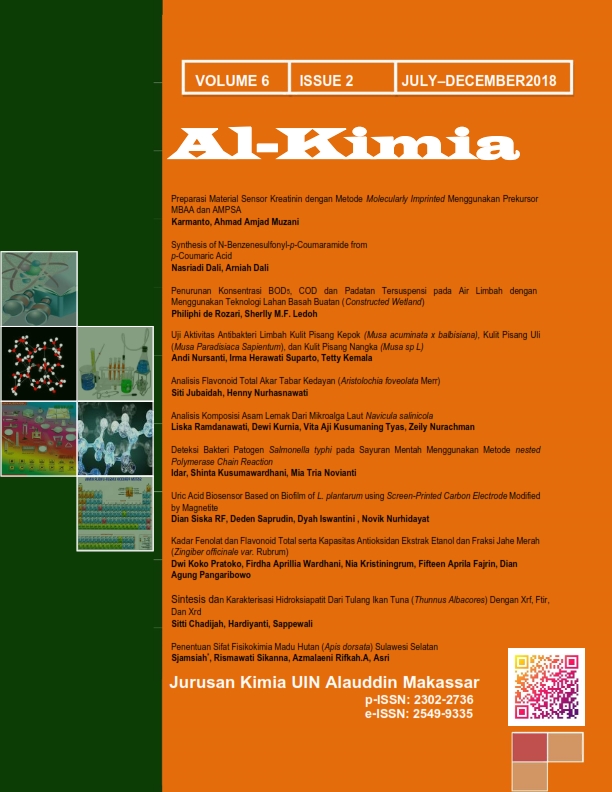Analisis Flavonoid Total Akar Tabar Kedayan (Aristolochia foveolata Merr)
Abstract
The tabar kedayan (Aristolochia foveolata Merr) plant located in the Malinau district of East Kalimantan has considerable biological active prospects as antioxidant, antibacterial, antiamuba, anti-inflammatory, antihepatotoxic and antiviral. One of the secondary metabolites in this plant is the flavonoids that can be used as antioxidants.The aim of this research are to analyze total flavonoid content of root tabar kedayan in fractionation with various nonpolar, semipolar and polar solvents. The analysis used in the determination of total flavonoid content using spectrophotometric method. Data of analysis used standard curve method based on absorbance data and concentration of standard solution. The results of this study obtained the highest total flavonoid average on ethyl acetate fraction of 1,09%±0,03 then n-hexane fraction of 0,52%±0,05 and the smallest level of ethanol-water fraction of 0,40%±0,03.
Downloads
References
Bharathajothi P, Bhaaskaran TC. (2014). Phytochemical and Pharmacological Evaluations of Aristoloceach Li bracteolate Lam. Pealgia Reseach
Library Chang CH, Yang MH, Wen HM, Chern JC. 2002. Estimation of total flavonoid content in propolis by two complementary colorimetric methods. Journal of Food and Drug Analysis. Vol 10(3):178-182.https://scholar.google.com. Diakses tanggal : 2 Mei 2108
Fadillah A, Rahmadani A, Rijai L. (2017). Analisis Kadar Total Flavonoid dan Uji Aktivitas Antioksidan Ekstrak Daun Kelubut (Passiflora foetida L).Proceeding of the 5th Mulawarman Pharmacetical Confrences: 21-28. https://prosiding.farmasi.unmul.ac.id. Diakses tanggal : 5 Mei 218.
Jubaidah, S. Apriliana, A. Wijaya, H. (2015). Uji Bioaktivitas Ekstrak Akar Tabar Kedayan (Aristolochia foveolata Merr). Media Sains. 8 (II) : 69-75.
Liwun, N.M. (2009). Inventarisasi dan Identifikasi Tanaman Obat yang Digunakan Oleh Suku Dayak Lundayeh di Kecamatan Muntarang Kabupaten Malinau Kalimantan Timur.KTI Akademi Farmasi Samarinda. Samarinda.
Rohyami, Y. (2008). “Penentuan Kandungan Flavonoid dari Ekstrak Metanol Daging Buah Mahkota Dewa (Phaleria macrocarpa Scheff Boerl)”.Jurnal logika Vol 5(1) : 1-8.https://journal.uii.ac.id. Diakses tanggal : 6 Mei 2108.
Sarker, S.D., dan Nahar, L. (2009).Kimia Untuk Mahasiswa Farmasi Bahan. Kimia Organik, Alam dan Umum. Yogyakarta: Pustaka Pelajar : 521-524.
Soobrattee, V.S. Neergheen, A. Luximon-Ramma, O.I.Aruoma, O.T. Bahorun. (2005). Phenolics as potential antioxidant thera-peutic agents: mechanism and actions, Mutat. Res. Fundam. 579: 200–213.
Turisman, Ardini, P. Nofiani, R. (2012). Total Fenol Fraksi Etil Asetat Dari Buah Asam Kandis ( Garcinia dioca Blume). JKK, 1(II) : 45-48.https://jurnal.untan.ac.id. Diakses tanggal : 13 Mei 2018.
Utami, Wahyu., Da’i, Muhammad., dan Negara, D. W. K., (2008). “Uji Aktivitas Penangkap Radikal Bebas Fraksi Non Polar Ekstrak Etanol Daun Dewandaru (Eugenia uniflora L.) Dengan Metode DPPH (2, 2-diphenyl-1-picrylhidrazyl) Beserta Penetapan Kadar Fenol Dan Flavonoidnya”. Jurnal Farmasi Indonesia. 9(2): 71.https://media.nelti.com. Diakses tanggal : 15 Mei 2018.
Copyright (c) 2018 Siti Jubaidah Jubaidah

This work is licensed under a Creative Commons Attribution-NonCommercial-ShareAlike 4.0 International License.
Authors who publish with this journal agree to the following terms:
1) Authors retain copyright and grant the journal right of first publication with the work simultaneously licensed under a Creative Commons Attribution License that allows others to share the work with an acknowledgement of the work's authorship and initial publication in this journal.
2) Authors are able to enter into separate, additional contractual arrangements for the non-exclusive distribution of the journal's published version of the work (e.g., post it to an institutional repository or publish it in a book), with an acknowledgement of its initial publication in this journal.
3)Authors are permitted and encouraged to post their work online (e.g., in institutional repositories or on their website) prior to and during the submission process, as it can lead to productive exchanges, as well as earlier and greater citation of published work (See The Effect of Open Access).


